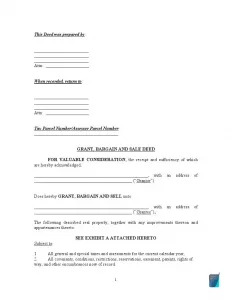Bargain and Sale Deed Form
A bargain and sale deed is a type of legal documents used within a change of real property ownership under US law. It is issued with limited warranties as to encumbrances that may be imposed on the property transferred. As such, it doesn’t guarantee that a new owner will not encounter problems with third-party claims to the property.
What Is a Bargain and Sale Deed?
Passing of real-estate ownership in the United States can be covered in several types of deeds, which vary in the level of new owners’ rights protection. While some of them guarantee good title, i.e., unencumbered in the past and/or in the present, a bargain and sale deed doesn’t usually imply such warranties. This document serves to state that a grantor has ownership rights in the real estate in question but doesn’t entail that no liens are attached to the property. The latter part refers to probable encumbrances placed on the property both during the grantor’s ownership and before it. So, a buyer coming into ownership under a bargain and sale deed will inherit all outstanding liens created against the asset. Obviously, it is likely to become an obstacle to obtaining title insurance coverage.
As it follows from the above, this legal document is composed without covenants clearly expressed in the written form. However, a would-be owner can still gain a greater level of protection against charges with certain warranties added to the deed. For example, bargain and sale deeds with covenants against grantor’s acts state that the current owner has taken no actions to result in any liens while being in ownership of the real estate. Namely, the NY Real Property Law Article 8, Section 258 provides the statutory form C for individuals to deliver this warranty, along with the similar CC form for corporate users. Including these covenants in the document makes it equal to a special warranty deed, which is also aimed at formalizing the grantor’s promise of no encumbrances imposed during their ownership. Yet, a deed with covenants against the grantor will be less protective for a new owner compared with a warranty deed.
When Is a Bargain and Sale Deed Used?
The limited warranty nature of bargain and sale deeds land them in a narrower usage with real-estate transactions since grantees are sure to prefer better protection through other types of deeds. However, grantors, in their turn, don’t want to be liable for possible encumbrances in case they could not exercise control over the property during the whole time of its existence. Specifically, this covers:
- property being sold by a lender under the right of foreclosure
- real estate falling under tax sales
- estate of a deceased person who did not leave any will
In the above cases, the grantor, be it a governmental entity, financial institution, estate administrator, or an individual owner, may not even know about liens placed on the property, which makes them seek protection against legal liability. For a buyer, property coming with a bargain and sale deed incurs higher risks, though covenants against grantor’s acts secure their “bona fide purchaser” status.
Bargain and Sale Deed vs. Quitclaim Deed
Because bargain and sale deeds refer to legal documents with a limited warranty, it can be easily confused with quitclaim deeds, which also do not offer safeguards against liens and similar limitations. However, the latter does not even imply that the grantor is a legal title owner — it transfers only the ownership rights that the grantor might have. In essence, the person signing the deed just confirms his or her refusal to claim their part in the property if they have such a right and transfers this right to the grantee. Thus, this type of deeds is seen as the least advantageous to a beneficiary, and its usage is usually limited to:
- transferring real estate between family members
- putting it into LLCs or trusts
- clearing up ambiguities in the title
Thus, quitclaim deeds are not common for buying and selling real estate.
What Should I Include in a Bargain and Sale Deed?
As it was mentioned before, some states provide approved yet nonprintable forms for bargain and sale deeds with or without covenants, while others just suggest rough wording and details to include. Generally, the deed would cover:
- the parties’ identifying information
- the legal description of the property
- the price of the property
- the date of signing the document
- the details of a notary public certifying the deed
- information about witnesses
- a statement about the property conveyance
Mind that not all states have similar requirements, but in most cases, the deed has to be signed by two witnesses along with mandatory notarization.

Filling Out a Bargain and Sale Deed Form
Having a bargain and sale deed form at hand facilitates real-estate transactions concluded with this type of legal documents. It reduces all the efforts to filling out a couple of blank fields while containing the required wording to take full legal effect immediately after participating parties sign it. For a buyer, it is better to opt for a form that includes covenants, but the steps for completing the forms with/without warranties will not vary.
Transaction Details
This part covers the parties’ full names and addresses along with the date when the document is signed and the price of the transaction. It also specifies the legal description of the property conveyed, including the unit number, lot, block, and section. After completing the details, the seller and the buyer sign the paper.
Notary Statement
To notarize the document, a notary public specifies the state and county he or she is appointed in, the date of signing the paper, the names of the parties and subscribing witnesses if any. Then, the notary public signs the deed and includes his/her commission expiration date.